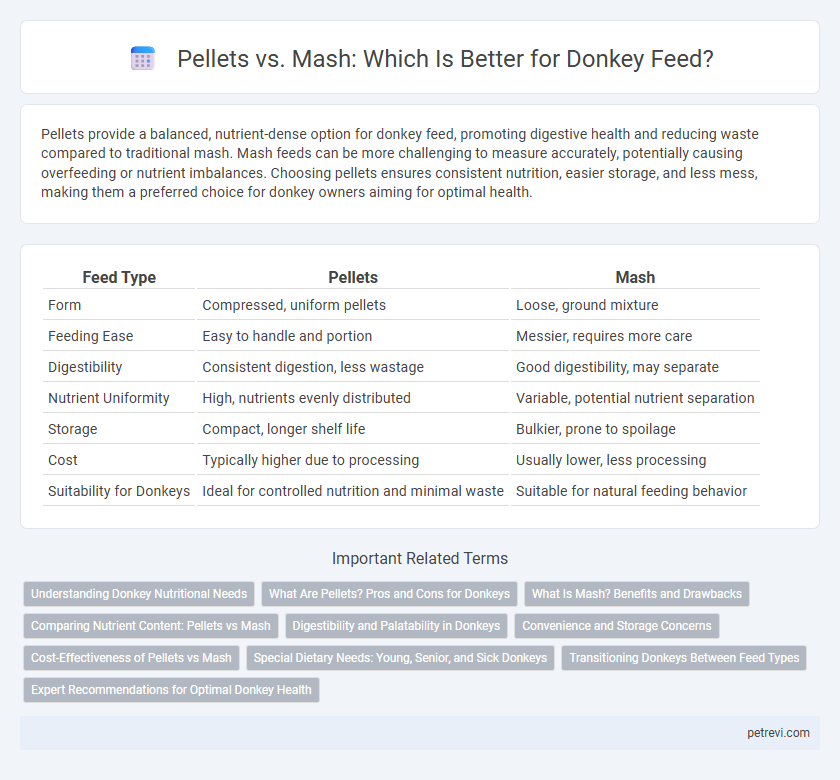Pellets provide a balanced, nutrient-dense option for donkey feed, promoting digestive health and reducing waste compared to traditional mash. Mash feeds can be more challenging to measure accurately, potentially causing overfeeding or nutrient imbalances. Choosing pellets ensures consistent nutrition, easier storage, and less mess, making them a preferred choice for donkey owners aiming for optimal health.
Table of Comparison
| Feed Type | Pellets | Mash |
|---|---|---|
| Form | Compressed, uniform pellets | Loose, ground mixture |
| Feeding Ease | Easy to handle and portion | Messier, requires more care |
| Digestibility | Consistent digestion, less wastage | Good digestibility, may separate |
| Nutrient Uniformity | High, nutrients evenly distributed | Variable, potential nutrient separation |
| Storage | Compact, longer shelf life | Bulkier, prone to spoilage |
| Cost | Typically higher due to processing | Usually lower, less processing |
| Suitability for Donkeys | Ideal for controlled nutrition and minimal waste | Suitable for natural feeding behavior |
Understanding Donkey Nutritional Needs
Pellets offer a consistent nutrient profile tailored to meet donkeys' fiber and mineral requirements, reducing the risk of selective feeding and digestive upset. Mash feed can provide a variety of ingredients but may lead to uneven nutrient intake, potentially compromising gut health and overall well-being. Understanding donkeys' strict need for high-fiber, low-sugar diets is critical when choosing between pellets and mash to support optimal digestion and energy balance.
What Are Pellets? Pros and Cons for Donkeys
Pellets for donkey feed are compressed mixtures of essential nutrients designed for easy digestion and uniform intake, reducing selective feeding and minimizing waste. Pros include consistent nutrient delivery, improved palatability, and reduced dust, which benefits donkeys with respiratory sensitivities. Cons involve potential overfeeding if not carefully monitored and higher cost compared to traditional mash, making proper portion control essential to prevent obesity and digestive issues.
What Is Mash? Benefits and Drawbacks
Mash is a finely ground mixture of grains and feed ingredients designed for easy digestion and quick consumption by donkeys. Its benefits include improved nutrient absorption, reduced choking risk, and suitability for older or dental-challenged donkeys. Drawbacks involve higher dust production, potential wastage due to scattering, and the need for careful preparation to maintain consistency and prevent spoilage.
Comparing Nutrient Content: Pellets vs Mash
Pellets for donkey feed typically offer a more uniform nutrient content, ensuring consistent protein, fiber, and energy levels essential for digestive health and overall vitality. Mash feed, while variable in nutrient density, can provide a broader range of natural fibers and may promote slower digestion, benefiting gut motility. Selecting between pellets and mash influences nutrient absorption and energy availability, impacting donkeys' weight management and metabolic health.
Digestibility and Palatability in Donkeys
Pellets offer higher digestibility for donkeys due to their uniform size and compact structure, which enhances nutrient absorption and reduces selective feeding. Mash feed provides greater palatability as it mimics natural forage textures, encouraging better intake in donkeys with sensitive eating habits. Choosing between pellets and mash requires balancing donkeys' digestive efficiency and preference to optimize health and performance.
Convenience and Storage Concerns
Pellets offer greater convenience for donkey owners due to their uniform size and ease of portion control, reducing feeding time and minimizing waste. Mash feed often requires mixing with water, posing challenges in preparation and increasing storage space needs due to bulkier packaging. Pellets typically have a longer shelf life and resist moisture better than mash, making them more suitable for long-term storage in varied environmental conditions.
Cost-Effectiveness of Pellets vs Mash
Pellets offer a more cost-effective feeding solution for donkeys due to their higher nutrient density and reduced waste compared to mash, which often requires larger quantities to meet dietary needs. Manufacturing pellets involves compacting ingredients, resulting in longer shelf life and less spoilage, thereby optimizing feed expenses. In contrast, mash feeds can be more prone to contamination and uneven nutrient distribution, potentially increasing overall feeding costs.
Special Dietary Needs: Young, Senior, and Sick Donkeys
Pellets provide a concentrated and uniform nutrient profile ideal for young, senior, and sick donkeys requiring easily digestible feed to support growth, maintenance, and recovery. Mash offers customizable feeding options, allowing adjustments for specific dietary needs such as increased fiber or added supplements for digestive health. Selecting between pellets and mash should consider the donkey's age, health status, and ability to chew, ensuring optimal nutrient absorption and overall well-being.
Transitioning Donkeys Between Feed Types
Transitioning donkeys from pellets to mash requires a gradual process over two to three weeks to avoid digestive upset and ensure proper nutrient absorption. Start by mixing a small proportion of the new feed with the old, gradually increasing the mash ratio while monitoring the donkey's health and stool consistency. Consistent access to fresh water and high-quality forage supports digestive balance during the feed transition.
Expert Recommendations for Optimal Donkey Health
Experts recommend pellets over mash for donkey feed due to better nutrient density and reduced dust, which enhances respiratory health. Pellets provide consistent, measured portions that aid in weight management and prevent selective feeding, ensuring balanced nutrition. Proper donkey health maintenance relies on high-fiber, low-sugar pellets that meet specific dietary needs while minimizing the risk of colic and laminitis.
Pellets vs Mash for Donkey Feed Infographic

 petrevi.com
petrevi.com